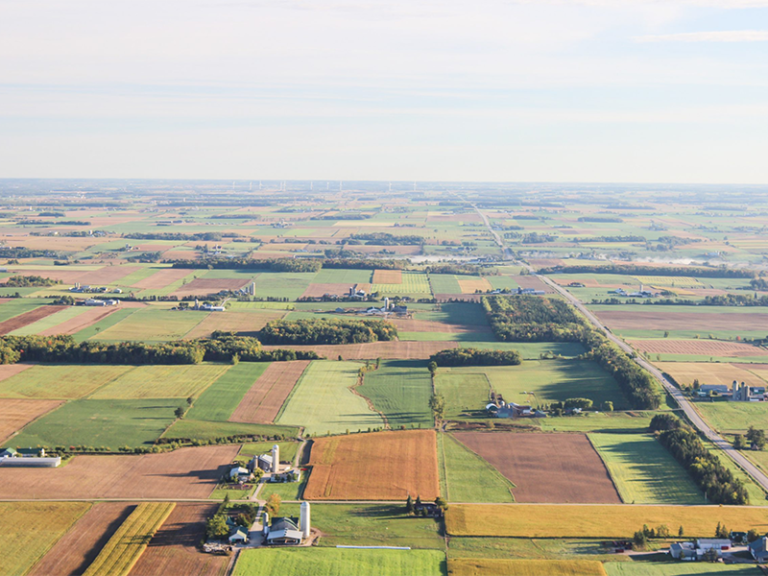First published: July 22, 2004
by Keith Oliver
This is the sixth in a series of articles about the process of planning for the growth and development of human settlements in general, and the 500 hectare northeast corner of Cobourg, known as Area C, in particular. 30 years from now, when this two square mile area is fully developed, Cobourg will be twice its present size.
The lack of innovative competition and housing choice.
In the fifth article in this series it was argued that the first thing we can do to break away from our totally automobile-dependent life-style is to begin planning and building better neighbourhoods with a centre, where residents can satisfy their daily and weekly shopping and service needs. Subsequent articles will describe the significant and proven cost benefits to the home-owner, local government and the developer of building such neighbourhoods.
Ironically, as the need for change grows, we become more intrenched in the status quo and continue to build vast residential areas that are no better than what was built following the Second World War. The dwelling types we are offered today continue to be limited to the single and semi-detached house, the town house, the three-storey walkup and high-rise apartments, all oriented toward streets that are becoming more and more congested.
Growth and development in Canada and the United States, has been carried out by independent, privately owned development corporations, all serving the private interests of their owners. While they claim to be guided by the demands of the market place, there is seldom if ever any attempt at real competition through innovation. As a developer grows from a start-up individual to a successful corporation, the ability to take risks and finance experiments in innovation increases, but the desire to do so declines. There is nothing as conservative as a successful development corporation.
The most visible and surest sign of this inertia is the fact that most developers follow one of several design-styles-of-the-moment. At present these are phoney French Chateau, phoney Victorian, or phoney Renaissance which includes a senseless display of fake columns and heavy cornices. You can guess the date of construction of development housing within 10 years by its outward appearance.
Public transit and pedestrian needs as an organizing principle.
Good town planning and architecture is the result of a disciplined and objective approach to problem solving. Charles Jeanneret, otherwise known as “Le Corbusier”, a revered French architect of the last century whose chapel at Ronchamp, France, is one of the most emotional pieces of architecture ever built, expressed this need for discipline when he coined the phrase “creation is a patient search!”. Part of that creative process is setting limits and establishing an organizing principle that can be broadly applied. If widely accepted, such a principle channels many different skills and interests toward accomplishing the same end. So it is with all good design that is intended to satisfy a human function, and its time we got back to it.
When considering the present state of human settlements and their consequences, especially in North America, that organizing principle must be to plan and build human settlements that reduce the need to travel, to develop an alternative transportation choice to that of the private automobile and to do so while maintaining and enhancing the quality-of-life for all.
The logical consequence of this objective is to organize overall land-use into sensible mixed-use transit destinations; increase the efficient use of land through developing a more compact urban form; and to build neighbourhoods that satisfy individual, family and community needs. To accomplish the latter we must increase average housing densities, offer a wider choice of housing types, satisfy the need for access to high quality private and public outdoor space, and provide every incentive possible for people to walk throughout their communities.
Gordon Cullen and “serial vision”.
It is easily apparent that in order for people to want to walk, there must
be a destination that is achievable within an acceptable period of time;
there must be a choice of several different routes and the experience must
be an interesting one; and in the case of neighbourhoods, the experience of
walking must offer the opportunity of a chance encounter with neighbours.
Otherwise how would one be kept up to date on community gossip?
With regard to how physical planning can make a pedestrian route
interesting, Gordon Cullen’s book “Townscape”, published in 1961,
established the town planning concept of “serial vision” and its importance
as an urban design goal and the book quickly became a town planning
classic. Made up mostly of photographs and drawings, “Townscape” codified
how interest and excitement is created as one moves along a pedestrian path
through a hypothetical town. Line-of-sight and vistas change from short to
long and back again; as more immediate visual destinations are reached, the
next becomes apparent; spaces as they are experienced open up, then become
enclosed, then open up again; the texture and fabric of the urban
experience changes back and forth from intimate to monumental.
While Cullen’s example was that of a medieval town without cars, the town
planning principles at work can easily be applied to a contemporary built
environment by mixing appropriate and compatible land-uses, angling the
layout of a street grid, off-setting street intersections, offering
short-cuts such as pedestrian-only pathways through the centre of
residential blocks, using trees to first conceal and then to reveal and
frame views, and taking advantage of natural land forms instead of applying
a bulldozer.
In successful urban design the presence of variety is often a key factor,
some of which can be planned from the beginning and some of which can only
be encouraged. Successfully inducing people to walk instead of drive
depends on the variety of visual and spacial and social experiences along
the way. The success of a centre-of-the-community as a meeting place that
attracts residents from different social and economic circumstances depends
on the centre offering the greatest possible variety of businesses and
services as well as its function as a link to a variety of public amenities
including transit and a public open space system.
A planned unit development at Halmstad, Sweden.
This planned unit development containing 160 dwellings and initiated by the Town of Halmstad almost 30 years ago, demonstrates that attractive innovation can be achieved by sticking with the proposed organizing principle and thinking with imagination and discipline “outside the box”. It illustrates how quality-of-life can be enhanced at higher housing densities. The density of 24 dwellings per hectare is twice that found on Westwood Drive or Chipping Park. There is 30% less asphalt and the length of municipal service runs to each house is shorter and four can be combined into one. The estimated savings in servicing costs is at least 15,000 dollars per dwelling.
Each home is assigned an open parking space and a garage and has a private garden equal to the ground floor area of the house. Each has a second floor balcony, a flower garden and a kitchen on its entrance side which faces onto a pedestrian-only pathway and hard-surface play area for children that reaches every home. All dwellings have easy access to high-quality public open space where one can throw a frisbee, or fly a kite, or hold a neighbourhood barbeque. The wide opening between buildings on the south side connects to other public open space in other planned developments.
Like every good solution there are trade-offs. Owners of the inside ring of homes are compensated for the fact that they must walk no more than one minute to their cars, by having their living-room and private garden open onto the public common. Owners of the outside ring of homes have more choice in house plans and their general configuration.
Halmstad is limited to semi-detached homes. In order to achieve an attractive transit-supportive average density of 36 dwellings per hectare, both lower and higher density housing must to be added to the mix. This will be the subject of the next articles.
Note: Part 6


